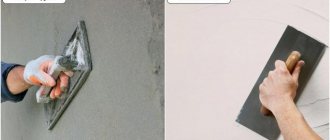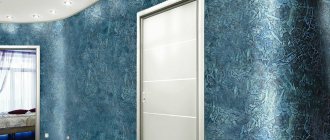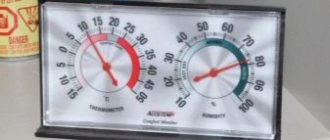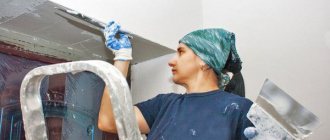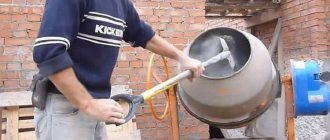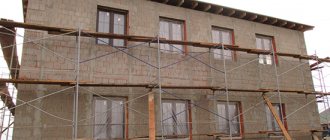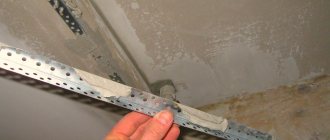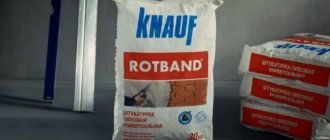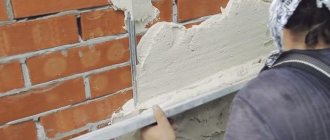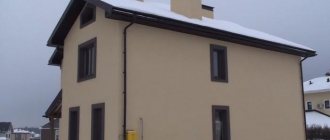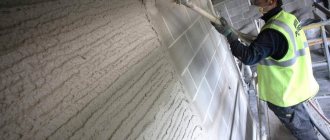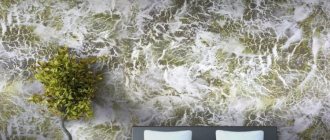Those who pick up a trowel or spatula for the first time, deciding to carry out repairs on their own, often cannot immediately decide: plaster and putty: what is the difference? Maybe they sell the same materials under different names in construction stores? And if different, can they be used for the same purposes? Let's get into the details.
Plaster and putty, what is the difference between them?
These are two fundamentally different processes and, of course, different compositions in terms of particle sizes. Let's start with plaster:
- The mixture consists of coarser substances.
- A solution prepared from such components is easily applied to substrates and fills all uneven areas and defects.
- Complete drying time takes several days.
- After drying, a rough but durable layer is formed on which tiles can be glued.
Putty differs from plaster:
- The presence of small particles of substances in the mixture.
- The prepared solution is more plastic, therefore it is applied in a thinner layer.
- Dries within 12-24 hours depending on the components.
- After such treatment, the surface of the ceiling, wall or slope will be smooth, without minor defects.
Types of materials
Plaster and putty are so popular among builders that they began to divide each one according to its purpose. From here came many types of solutions that are used to achieve certain goals.
Types of decorative plaster mixtures:
- Colored - ideal for interior decoration.
- Stone - creates an imitation of natural stone.
- Venetian - resembles marble.
- Sgraffito - consists of two or more layers and is similar to painting.
- Terrasite - a multi-component composition creates a beautiful rough surface.
- Silk - the so-called liquid wallpaper.
In addition to the most common lime, gypsum and cement-sand mortars, you can also find special mixtures. For example, magnesium plaster is intended for interior work, when it is necessary to ensure high non-combustibility of the object.
What comes first, plaster or putty?
If a major renovation is being carried out in the room, then you need to decide what to apply first: plaster or putty. To do this, you need to remember that plaster, thanks to its larger components, easily eliminates large imperfections on the surface.
After the solution has completely hardened, you still end up with a rough surface that still needs to be refined before you start decorating. To do this, use a mixture with small fractions of substances, that is, putty. Therefore, the putty solution is applied second to the plaster layer.
Video description
The video will show what kind of putty or plaster there is and what is the difference between them:
Types of putty mixtures:
- Oil – used to protect the surface from excessive moisture. Consists of drying oil, driers and chalk.
- Adhesive – characterized by increased adhesion. It contains the same drying oil and chalk. Glue is also added.
- Oil-adhesive – prepares the surface for painting or wallpapering.
- Gypsum is considered the most environmentally friendly.
- Epoxy – perfectly protects against most chemical aggressions.
- Polyester – used for restoration of metal after corrosion damage.
- Latex - for sealing drywall seams.
- Putty – levels plastered surfaces.
- Acrylic universal - suitable for literally any surface. Often used to repair plaster.
- Acrylic façade – resistant to moisture and ultraviolet radiation. Good abrasion resistance.
- Based on PVA - for sealing cracks and joints.
Plaster or putty reliably protects the surface from moisture and perfectly eliminates various defects. Only the thickness of the overlay is different. The minimum layer of plaster is 10 mm. And the maximum thickness of the putty is only 1 mm.
Distribution of putty over the surface Source mirbetona.info
What types of mixtures are there and what do they consist of?
In construction stores, customers are offered various mixtures for plastering and puttying. They are almost identical in composition, but in grain size they differ greatly. There are mixtures:
- cement;
- gypsum;
- calcareous.
Cement
This mixture consists of cement, sand and additional components (plasticizers, moisture-repellent and strengthening substances).
Cement plaster has a number of advantages:
- Affordable price.
- High strength.
- Heat and sound insulation properties.
- Possibility of applying a layer of up to 5 cm using a reinforcing structure.
- Duration of operation, both indoors and on external walls.
- High adhesion coefficient.
In addition to the positive aspects, there are also several negative ones:
- Labor-intensive application.
- The hardened layer is rough and must be covered with putty.
- The material takes a long time to harden. Some compositions dry completely after 2-3 weeks.
Cement putties have the same advantages and disadvantages as plasters. But such puttying is used in cases where the decorative material is heavy, for example, tiles. This is where the difference lies.
Plaster
This type of plaster is used only for indoor work. But here you need to be very careful. It is advisable not to choose gypsum plaster if the surface is exposed to:
- High humidity.
- Constant and sudden temperature changes.
- Mechanical damage.
The solution is flexible, easy to apply and smoothes out effortlessly. Apply a layer of up to 5 cm, which dries faster than a cement composition. But the main component (gypsum) absorbs moisture from the environment and at the same time loses its properties. Quickly damaged by mechanical stress.
Someone has a question about the difference between gypsum plaster and gypsum putty. As mentioned above, plasters, unlike putties, are used to level a base made of concrete, brick or other material. Components in a mixture of larger fractions. Putty is used only to level the surface before decorative finishing.
Limestone
Lime-based compositions are used only for interior work. The plaster solution is not expensive and is easy to apply to surfaces. This material is considered environmentally friendly. But several disadvantages offset the advantages. These include:
- Fragility.
- Short service life.
That is why lime compounds are already losing their former popularity.
Areas of use
Let's consider why these two building materials are needed.
Plaster is used for:
- Alignment of large curvatures of walls.
- Elimination of potholes, cracks and other large defects on walls.
- As an intermediate (bearing) layer before finishing. For example, even smooth walls made of aerated concrete are pre-plastered before wallpapering or tiling.
- For heat and sound insulation, protection from moisture, fire and even radiation.
- As an independent finishing finishing of facades and interior walls.
As you can see, plastering is a fairly universal wall covering; it is used both inside and outside the house, for residential and work buildings, utility rooms and garages.
The putty can also be used for interior and exterior work.:
- Puttying plastered walls before wallpapering or painting.
- Hiding drywall joints and screw heads.
- Elimination of minor defects, holes, cracks and pits.
- Repair of plaster, chips and scratches of decorative coating.
Above, we have already noted the difference between a plastered and puttied wall - their smoothness. When you need to create an ideal surface, it is better to putty on top of the plaster and go over it with a soft grater. When you can do without putty when finishing walls will be discussed below.
Approximate price per square meter
The cost of performing work by professional craftsmen will vary depending on the composition of the plaster and putty and the thickness of the layer. For plastering with cement mixture you will have to pay 400-500 rubles, including materials. If the owner of the apartment buys the material, the cost of the work is 250-270 rubles per square meter.
Work with gypsum plaster will cost a little more: 500-525 rubles and 270-300 rubles per square meter, including and without materials, respectively.
Since the putty is applied in a thinner layer, the cost will, of course, be cheaper. From 100 to 150 rubles/m2. But you can do everything yourself, and why then overpay for the services of craftsmen.
When can you not putty?
If you choose tiles for decorative finishing, then there is no need to putty the walls. A slight roughness in this case will be preferable. The adhesive solution will hide small unevenness, but at the same time the decor will be securely fixed.
In the case where wallpaper, painting or whitewashing will be used for finishing, the walls must be puttied. If this is not done, then the unsightly gray surface will be visible through the canvas. This is especially noticeable when a light shade is chosen.
Drywall is also puttied over the entire area before finishing. Otherwise, the wallpaper will stick so firmly that you can only tear it off at the base. Examples of unsuccessful experiments are presented in photos on the Internet.
What is the difference between plaster and wall putty in the technology of work execution?
Two different materials must be applied using a special technology. Let's start with plaster, because it is applied first to the ceiling and walls. This process is carried out in four stages:
- The base is being prepared. To do this, possible contamination is cleaned and fasteners are removed. It is also necessary to apply a primer, which will increase adhesion and protect the base from the development of fungus and mold.
- The first layer is a spray. The solution, whose consistency resembles thick sour cream, is thrown onto the wall and allowed to dry. When spraying, the movements are sharp, but not sweeping, so that the mixture does not fly apart.
- The second layer is soil. A thicker and more flexible solution is poured over the first one, but in a thinner layer. Now everything is aligned. To do this, use a wide spatula or a rule about a meter in size. After leveling, the layer is allowed to dry.
- The third layer is the covering. Now the solution is not thrown onto the surface, but rubbed in. This requires mixtures with small particles and often putty is used instead of finishing plaster. The prepared solution, in a small amount, is scooped onto a wide spatula and movements are made from bottom to top. In this case, the hand draws an arc. Professionals find this method of application convenient. After the layer has dried, grouting is performed. The movements are circular, counterclockwise.
Some people think that after such actions there is no longer any need to putty. And it is true. If everything was done correctly and a putty mixture was used for covering, there is no need to waste your time and putty the surface again. But if you are not satisfied with the smoothness of the third layer after rubbing, then apply another layer of putty:
- Professionals recommend starting with a primer. It must be applied both before and after puttying.
- The solution is prepared strictly according to the instructions indicated by the manufacturer on the packaging.
- The finished mixture is rubbed into the base with a wide spatula. Everything straightens out right away.
- Grouting is done after the solution has hardened. To do this, a grater with a rubber or metal pad is moistened in water (gypsum milk if the putty composition is gypsum based) and confident movements from top to bottom are carried out over the entire area. The same procedure is performed horizontally.
